
On June 12, 2019, the Penn Museum moved their famous Sphinx for the first time since 1924. After nearly 95 years in its home in the Lower Egyptian Gallery, the granite Sphinx of Ramses II, the largest ancient sphinx housed in the Western Hemisphere, took a trip through the museum’s courtyard to its new home in the soon-to-be renovated main entrance, making it one of the first objects visitors will see.
According to Dr. Jennifer Houser Wegner, an Associate Curator in the Egyptian Galleries and Egyptologist specializing in Egyptian language, the Sphinx was excavated in 1912 near the Ptah Temple in Memphis by W. M. Flinders Petrie, and was gifted to the museum as a result of their financial support of his work. For the first few years of its residence at the Penn Museum, the Sphinx sat outside in the garden, but in 1916 was moved inside due to concerns about deterioration. It was moved again in 1924 to the Lower Egyptian Gallery, which opened to the public in 1926, where it remained until the summer of 2019.
The Sphinx is dated back to New Kingdom Egypt, and is believed to have been constructed between 1293-1185 BCE. After spending years buried under the sand from the shoulders down, most of the object is still intact. The head, however, has sustained damage over the centuries from exposure to sand, wind, and direct sunlight. Despite the damage, the Sphinx has been identified as depicting Ramses II, otherwise known as Ramses the Great. The statue is made of granite, measures approximately 362cm in length, 145cm in width, and weighs just under 13 tons.
In preparation for the move, I spoke to Bob Thurlow, the Project Manager. Unfortunately due to unforeseen circumstances, I would have to miss the move itself; however, Mr. Thurlow described the procedure in detail to me in the days leading up to the event, and upon my arrival at the Penn Museum the following day, the scaffolding used to move the statue across the premises was still up. Thurlow explained how the move didn’t enter the planning stages until October 2018, despite the Sphinx exhibit having been closed in July 2018. Thurlow explains that, in 2019, it was “a lot less effort” to move the statue; “In the 1920s, it took 40 men and 15 horses to move it,” he said. “Now, it’ll take a compressor and eight people on the rigging and art handling team, plus the conservation team. The whole team will be made up of twelve people.” In order to complete the move, a scaffold was constructed through the courtyard, creating a clear path without closing off significant portions of the museum. The Sphinx traveled from left to right on the pathway, taking two turns before arriving at the main entrance. The moving team also had to work with a 20-degree incline. In order to complete the move with such a small team, they utilized what Thurlow described as “hoverboards.” The statue’s weight and density was a major concern for the move; composed of red granite, with a weight of approximately 25,000 lbs unevenly distributed with the right side weighing more than the left, the possibility of disaster was ever present. The team slipped air dollies underneath the statue, which released pressurized air that lifted the Sphinx a couple inches off the ground, making transport easier and safer.
______________________________
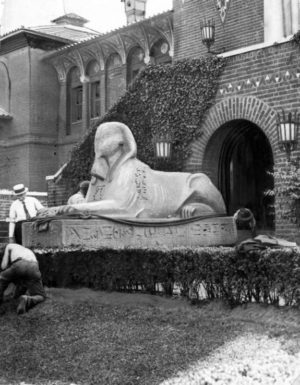
Photograph of the Sphinx during its last move in the 1920s. Photo Credit: University Communications, University of Pennsylvania
______________________________
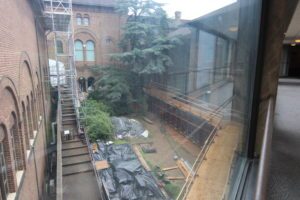
View of scaffolding path from inside the Penn Museum. Photo Credit: Noelle Myers
______________________________
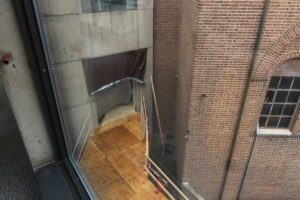
Outdoor view of the entryway in which the Sphinx re-entered the building. Photo Credit: Noelle Myers
______________________________
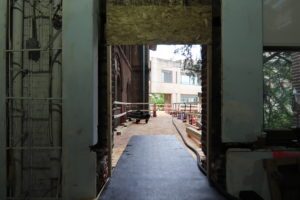
The view of the entryway used to re-enter the Sphinx through the building from the inside. Photo Credit: Noelle Myers
______________________________
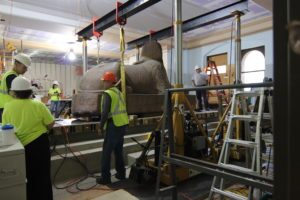
The Sphinx inside the Main Entrance hall during renovations with the crew. Photo Credit: Noelle Myers
______________________________
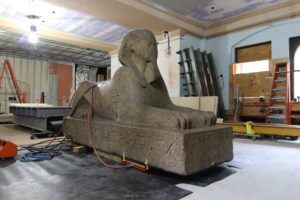
Side view of the Sphinx alone in the Main Entrance hall during renovations. Photo Credit: Noelle Myers
______________________________

Head on view of the Sphinx alone in the Main Entrance hall during renovations. Photo Credit: Noelle Myers
______________________________
The reception to watch the move was held on June 12, 2018 in the Mosaic Garden overlooking the courtyard, and the event was recorded and streamed on the Penn Museum’s Facebook page. Everyone I spoke to about the move expressed their excitement for the completed project, and the “wow factor” visitors will experience upon entering the museum and seeing the Sphinx for the first time.
More Changes and New Openings
The successful relocation of the Sphinx is only part of a much bigger plan for change at the Penn Museum, however. In addition to the newly renovated main gallery, which is set to open in the Fall of 2019, changes will include select artifacts from each exhibit, giving visitors a precursory view of 10,000 years of human history. Visitors will also get to enjoy several new exhibits.
During the summer of 2018, when I saw the Sphinx for the last time before the Lower Egyptian Gallery was closed to the public, I also reported on the newly renovated Middle Eastern Galleries. Featuring a wide variety of objects ranging from pottery and coins to Queen Puabi’s headdress, the Middle Eastern Galleries are designed to tell the story of the birth of human civilization, drawing parallels between our ancestors and our modern societies. In addition to the objects themselves, visitors will also have the opportunity to join tours led by refugees, offering a modern, personal take on different archaeological locations as they tell their stories.
Another newly opened exhibit is the Native American Voices exhibit. Featuring objects from Native American tribes across North America and ranging from ancient to modern, the exhibit paints a clear picture of Native American life and gives a voice to these historically oppressed cultures. The most riveting part of the exhibit is the video projection in the middle of the room. Surrounded by benches to resemble a campfire, the projector is motion sensored, beginning the narrated video when it senses motion within its space. The video consists of several members of Native American communities, and tells their story in their own words.
Slated to open this fall are the African, and Mexico/Central American Galleries. Both exhibits have been closed since 2018 and are being redesigned to tell a more accurate history of these regions of the world. The African gallery, for example, will focus heavily on the colonization of the continent and address the often illicit practices in which many of our African artifacts in the West have been acquired over the centuries. As the Penn Museum has acquired most of their African collections through purchase, as opposed to excavation, the colonization and exploitation of these cultures is a conversation the museum wants to encourage with its new gallery.
_____________________________
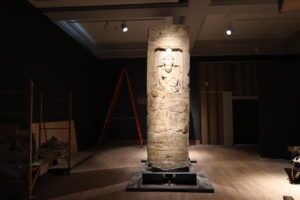
A lone stele that will be a central feature in the Mexico and Central America Gallery. Photo Credit: Noelle Myers
_____________________________
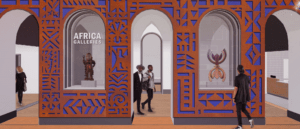
A preview of the upcoming African Galleries at the Penn Museum. Photo Credit: University Communications, University of Pennsylvania
_____________________________
These changes are meant to promote the mission of the Penn Museum, which is to “transform understanding of the human experience.” When asked what he hopes visitors will take from their experience at the museum, Dr. Julian Siggers, director of the museum, said, “We want people to know we are your museum.” Dr. Siggers, who has been the director of the Penn Museum for seven years, described the importance of field work at the Penn Museum and how the museum is working to interpret that research. There are 10,000 years of history housed within the Penn Museum’s walls, with a renewed focus on telling everyone’s story in a more inclusive environment.
The Sphinx will be on display again on November 16, 2019.
____________________________
About the Penn Museum
The Penn Museum (the University of Pennsylvania Museum of Archaeology and Anthropology) is dedicated to the study and understanding of human history and diversity. Founded in 1887, the Museum has sent more than 300 archaeological and anthropological expeditions to all the inhabited continents of the world. With an active exhibition schedule and educational programming for children and adults, the Museum offers the public an opportunity to share in the ongoing discovery of humankind’s collective heritage.
The Penn Museum is located at 3260 South Street, Philadelphia, PA 19104 (on Penn’s campus, across from Franklin Field). Public transportation to the Museum is available via SEPTA’s Regional Rail Line at University City Station; the Market-Frankford Subway Line at 34th Street Station; trolley routes 11, 13, 34, and 36; and bus routes 21, 30, 40, and 42. Museum hours are Tuesday through Sunday, 10:00 am to 5:00 pm, and first Wednesdays of each month until 8:00 pm. Open select holiday Mondays. Museum admission donation is $15 for adults; $13 for senior citizens (65 and above); free for U.S. Military; $10 for children and full-time students with ID; free to Penn Museum Members, PennCard holders, and children 5 and younger.
___________________________
If you liked this article, you may like Merenptah Rising, a major feature article published previously at Popular Archaeology.
___________________________




